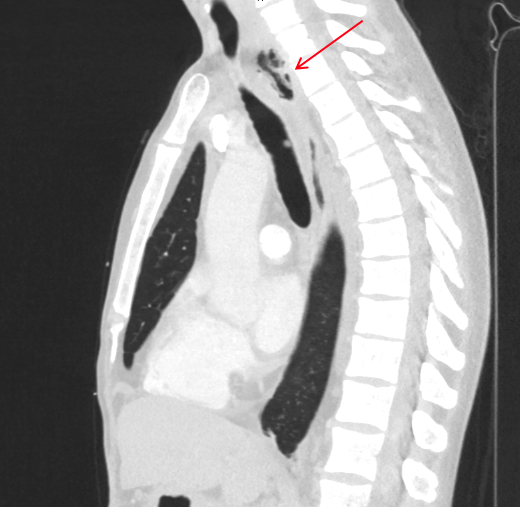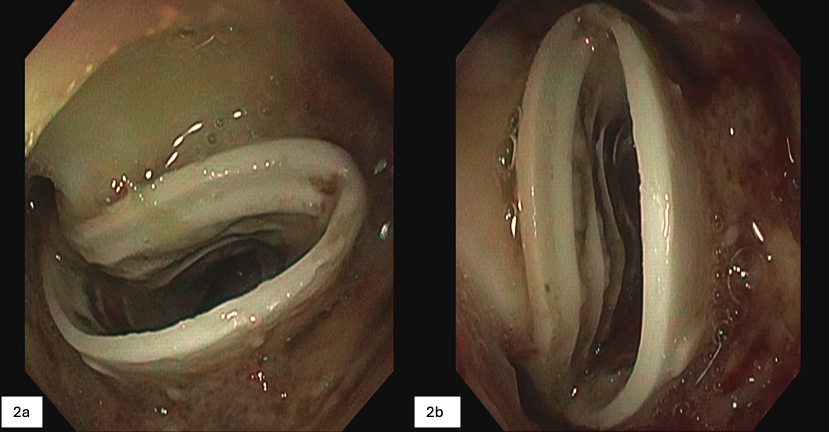Monday Poster Session
Category: Esophagus
P2882 - Recurrent Foreign Body Ingestions Resulting in an Unretrievable Esophageal Foreign Body
Monday, October 27, 2025
10:30 AM - 4:00 PM PDT
Location: Exhibit Hall
.jpg)
Sneh Parekh, DO
University of Florida College of Medicine
Jacksonville, FL
Presenting Author(s)
Sneh Parekh, DO1, Yasasvhinie Santharam, DO1, Claudia Aleman Oliva, DO1, Luke Stachler, MD1, Mohsin Ali, MD2, Radhika Sharma, DO1, Laura Suzanne K.. Suarez, MD1, Bruno Ribeiro, MD1, Lauren Stemboroski, DO1
1University of Florida College of Medicine, Jacksonville, FL; 2Orange Park Medical Center, Orange Park, FL
Introduction: Ingested foreign bodies are a common gastrointestinal emergency, often seen as accidental ingestions with food. Recurrent foreign body ingestions, however, are defined by the repeated and often intentional ingestion of non-food items and are often secondary to mental health disorders. Complications such as ulceration, perforation, and fistula formation at various places within the GI tract can occur through recurrent foreign body ingestions, ultimately resulting in numerous endoscopic challenges, including with retrieval of the foreign bodies. Here, we present the case of a 39-year-old male with documented history of recurrent foreign body ingestions.
Case Description/
Methods: A 39-year-old male with documented history of schizophrenia and over 30 prior foreign body ingestions, including toilet paper rolls, cardboard, and plastic bottles, presented for evaluation of an esophageal mass. The patient had a 2-month history of progressively worsening dysphagia to solids, with associated vomiting and coughing. On imaging, a CT of the chest showed a mass-like thickening of the esophagus with presence of the foreign body and a CT of the soft tissue of the neck showed soft tissue attenuation within the esophagus, suggesting a non-radiopaque foreign body. Esophagogastroduodenoscopy (EGD) revealed a circular foreign body in the upper esophagus along with circumferential ulceration. The foreign body was lodged into the esophageal wall secondary to the trauma and ulceration of prior foreign body ingestions. As such, EGD was unsuccessful in removal and the patient was then referred for surgical removal.
Discussion: The prevalence of foreign body ingestion is more common in adults with psychiatric disorders, than in those without, as around 79-85% of intentional foreign body ingestion cases involve patients with psychiatric disorders. Recurrent foreign body ingestions are also more common in the psychiatric population, and are more likely to result in trauma, ulceration, and other pathological changes of the GI tract. These alterations to normal anatomy can result in impaction of foreign bodies within the GI tract, leading to significant challenges to endoscopic intervention, often necessitating surgical assistance, as seen in our patient. A review of literature shows the rarity of this, as only about 1-3% of esophageal foreign bodies are irretrievable by endoscopic intervention, requiring surgery.

Figure: Figure 1: CT of the chest showing the impacted foreign body within the esophagus, indicated by the red arrow.

Figure: Figures 2a and b: An unknown circular foreign body lodged within the upper esophagus with surrounding circumferential ulceration and tissue growth, as seen on EGD.
Disclosures:
Sneh Parekh indicated no relevant financial relationships.
Yasasvhinie Santharam indicated no relevant financial relationships.
Claudia Aleman Oliva indicated no relevant financial relationships.
Luke Stachler indicated no relevant financial relationships.
Mohsin Ali indicated no relevant financial relationships.
Radhika Sharma indicated no relevant financial relationships.
Laura Suzanne Suarez indicated no relevant financial relationships.
Bruno Ribeiro indicated no relevant financial relationships.
Lauren Stemboroski indicated no relevant financial relationships.
Sneh Parekh, DO1, Yasasvhinie Santharam, DO1, Claudia Aleman Oliva, DO1, Luke Stachler, MD1, Mohsin Ali, MD2, Radhika Sharma, DO1, Laura Suzanne K.. Suarez, MD1, Bruno Ribeiro, MD1, Lauren Stemboroski, DO1. P2882 - Recurrent Foreign Body Ingestions Resulting in an Unretrievable Esophageal Foreign Body, ACG 2025 Annual Scientific Meeting Abstracts. Phoenix, AZ: American College of Gastroenterology.
1University of Florida College of Medicine, Jacksonville, FL; 2Orange Park Medical Center, Orange Park, FL
Introduction: Ingested foreign bodies are a common gastrointestinal emergency, often seen as accidental ingestions with food. Recurrent foreign body ingestions, however, are defined by the repeated and often intentional ingestion of non-food items and are often secondary to mental health disorders. Complications such as ulceration, perforation, and fistula formation at various places within the GI tract can occur through recurrent foreign body ingestions, ultimately resulting in numerous endoscopic challenges, including with retrieval of the foreign bodies. Here, we present the case of a 39-year-old male with documented history of recurrent foreign body ingestions.
Case Description/
Methods: A 39-year-old male with documented history of schizophrenia and over 30 prior foreign body ingestions, including toilet paper rolls, cardboard, and plastic bottles, presented for evaluation of an esophageal mass. The patient had a 2-month history of progressively worsening dysphagia to solids, with associated vomiting and coughing. On imaging, a CT of the chest showed a mass-like thickening of the esophagus with presence of the foreign body and a CT of the soft tissue of the neck showed soft tissue attenuation within the esophagus, suggesting a non-radiopaque foreign body. Esophagogastroduodenoscopy (EGD) revealed a circular foreign body in the upper esophagus along with circumferential ulceration. The foreign body was lodged into the esophageal wall secondary to the trauma and ulceration of prior foreign body ingestions. As such, EGD was unsuccessful in removal and the patient was then referred for surgical removal.
Discussion: The prevalence of foreign body ingestion is more common in adults with psychiatric disorders, than in those without, as around 79-85% of intentional foreign body ingestion cases involve patients with psychiatric disorders. Recurrent foreign body ingestions are also more common in the psychiatric population, and are more likely to result in trauma, ulceration, and other pathological changes of the GI tract. These alterations to normal anatomy can result in impaction of foreign bodies within the GI tract, leading to significant challenges to endoscopic intervention, often necessitating surgical assistance, as seen in our patient. A review of literature shows the rarity of this, as only about 1-3% of esophageal foreign bodies are irretrievable by endoscopic intervention, requiring surgery.

Figure: Figure 1: CT of the chest showing the impacted foreign body within the esophagus, indicated by the red arrow.

Figure: Figures 2a and b: An unknown circular foreign body lodged within the upper esophagus with surrounding circumferential ulceration and tissue growth, as seen on EGD.
Disclosures:
Sneh Parekh indicated no relevant financial relationships.
Yasasvhinie Santharam indicated no relevant financial relationships.
Claudia Aleman Oliva indicated no relevant financial relationships.
Luke Stachler indicated no relevant financial relationships.
Mohsin Ali indicated no relevant financial relationships.
Radhika Sharma indicated no relevant financial relationships.
Laura Suzanne Suarez indicated no relevant financial relationships.
Bruno Ribeiro indicated no relevant financial relationships.
Lauren Stemboroski indicated no relevant financial relationships.
Sneh Parekh, DO1, Yasasvhinie Santharam, DO1, Claudia Aleman Oliva, DO1, Luke Stachler, MD1, Mohsin Ali, MD2, Radhika Sharma, DO1, Laura Suzanne K.. Suarez, MD1, Bruno Ribeiro, MD1, Lauren Stemboroski, DO1. P2882 - Recurrent Foreign Body Ingestions Resulting in an Unretrievable Esophageal Foreign Body, ACG 2025 Annual Scientific Meeting Abstracts. Phoenix, AZ: American College of Gastroenterology.
